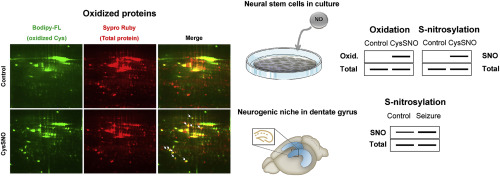Redox Biology ( IF 11.4 ) Pub Date : 2020-02-07 , DOI: 10.1016/j.redox.2020.101457 Ana Isabel Santos 1 , Ana Sofia Lourenço 1 , Sónia Simão 2 , Dorinda Marques da Silva 3 , Daniela Filipa Santos 3 , Ana Paula Onofre de Carvalho 4 , Ana Catarina Pereira 4 , Alicia Izquierdo-Álvarez 5 , Elena Ramos 5 , Esperanza Morato 6 , Anabel Marina 6 , Antonio Martínez-Ruiz 7 , Inês Maria Araújo 2

|
Nitric oxide (NO) is well established as a regulator of neurogenesis. NO increases the proliferation of neural stem cells (NSC), and is essential for hippocampal injury-induced neurogenesis following an excitotoxic lesion. One of the mechanisms underlying non-classical NO cell signaling is protein S-nitrosylation. This post-translational modification consists in the formation of a nitrosothiol group (R–SNO) in cysteine residues, which can promote formation of other oxidative modifications in those cysteine residues. S-nitrosylation can regulate many physiological processes, including neuronal plasticity and neurogenesis. In this work, we aimed to identify S-nitrosylation targets of NO that could participate in neurogenesis. In NSC, we identified a group of proteins oxidatively modified using complementary techniques of thiol redox proteomics. S-nitrosylation of some of these proteins was confirmed and validated in a seizure mouse model of hippocampal injury and in cultured hippocampal stem cells. The identified S-nitrosylated proteins are involved in the ERK/MAPK pathway and may be important targets of NO to enhance the proliferation of NSC.
中文翻译:

通过硫醇氧化还原蛋白质组学鉴定神经干细胞中S-亚硝基化的新靶标。
一氧化氮(NO)是公认的神经发生调节剂。NO增加神经干细胞(NSC)的增殖,对于兴奋性毒性病变后海马损伤诱导的神经发生至关重要。非经典NO细胞信号转导的基础机制之一是蛋白质S-亚硝基化。这种翻译后修饰包括在半胱氨酸残基中形成亚硝基硫醇基(R–SNO),这可以促进这些半胱氨酸残基中其他氧化修饰的形成。亚硝基化可以调节许多生理过程,包括神经元可塑性和神经发生。在这项工作中,我们旨在确定可以参与神经发生的NO的S-亚硝基化目标。在NSC中,我们鉴定了一组使用硫醇氧化还原蛋白质组学的互补技术进行氧化修饰的蛋白质。在癫痫发作的海马损伤小鼠模型和培养的海马干细胞中,已证实并验证了其中一些蛋白的S-亚硝基化作用。鉴定出的S-亚硝基化蛋白参与ERK / MAPK途径,可能是NO增强NSC增殖的重要靶标。


























 京公网安备 11010802027423号
京公网安备 11010802027423号